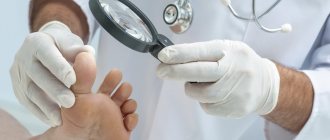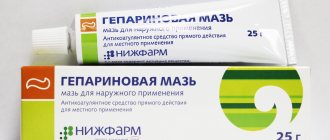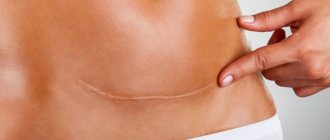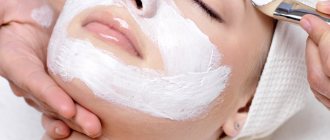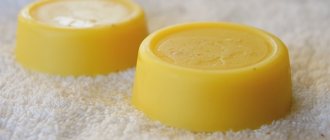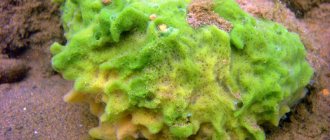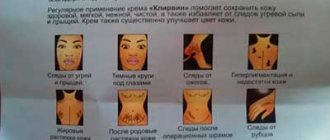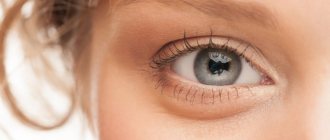Laser therapy can eliminate scars and scars, making them less noticeable
We are talking about formations consisting of connective tissue that form after wounds heal. They can be either a consequence of surgery or a result of injury.
It is very easy to visually distinguish a scar from healthy skin - it has a different shade. There is often no hair in the area of damage to the epidermis. And if for men this is real “decoration”, then for women it is a huge problem, and a psychological one at that. But don’t despair, because you can get rid of such “neighborhood” with the help of a laser. How exactly? – Read below.
What is laser resurfacing?
Laser treatment of scars is the only procedure today that allows you to permanently get rid of a cosmetic defect that causes discomfort or significantly reduce the depth of the defect. Depending on the complexity of the defect, it may take several sessions to completely remove it. The second name of the procedure is laser dermabrasion, literally “burning out the epidermis layer with a laser.” The effectiveness of the method is based on the skin's ability to absorb radiation photons. During the session, the laser beam heats the dermal tissue. Heating causes water molecules to evaporate. The fabric is destroyed. The intensity of the beam determines how deeply the skin will be “burned out.” Throughout the entire depth of the laser-affected area, chemical compounds are destroyed: collagen, elastane, protein. Since there are healthy cells nearby that the beam does not touch, they begin to actively divide, replacing the scorched ones. So, in place of the healed tissue, a new, healthy, smooth and even one appears.
The cosmetic procedure evens out the skin and significantly reduces the appearance of the scar.
The drug Collost
These are injections with bovine collagen fibers, which, when introduced into the human body, increase the independent production of collagen. This increases tissue elasticity and activates the processes of regeneration of scars and wrinkles.
"Collost" copes well with stretch marks, traces of infectious rashes, acne and scars. A collostotherapy session is performed in a specialized cosmetology clinic by a highly qualified doctor.
The advantages of this type of rejuvenation and skin improvement are:
- safety;
- absence of injuries;
- no recovery period;
- long lasting effect after the first use.
To carry out each of the listed methods for improving the condition of the dermis, you must consult a doctor.
SkinLazerMed Medical Center invites you to attend a free consultation on the day of one of the procedures. Here you will be answered all your questions about the removal of scars, stretch marks, etc. Only certified devices are used. Prices for services provided are the most affordable among cosmetology clinics in St. Petersburg.
What types of scars are removed using laser dermabrasion?
Several treatment sessions help get rid of any type of imperfections, regardless of how long ago they appeared. Scars that resurfacing can remove:
- normotrophic – light, thin, appear after injuries to the skin;
- atrophic – marks from post-acne, look like pits;
- hypertrophic – colorless tubercles, “tucks”;
- keloids - red “mounds” that appear at the site of acne or burns;
- postoperative - other types of defects that are formed at the site of the cut with a scalpel.
Photos before and after, results
The result is noticeable after 2-3 sessions. To achieve the desired effect, experts recommend taking a full course of laser resurfacing, during which the scars will resolve. Renewed and healthy skin appears at the site of defects.
Advantages and disadvantages of the method
The method of eliminating cosmetic blemishes described in our article has a number of advantages:
- costs less than plastic surgery;
- has greater effectiveness compared to cosmetics;
- does not affect healthy tissue, has a targeted effect;
- provides comfort during the session;
- is relatively painless;
- implies an individual approach to the client;
- provides long-term results;
- characterized by a short rehabilitation period.
There are some disadvantages:
- side effects during rehabilitation (discomfort, swelling, redness, pain);
- Possibility of carrying out only in a salon or clinic;
- high price;
- risk of scar infection if sterile conditions are not provided;
- the need for several sessions if the scar is complex or old;
- the inability to remove the defect quickly; a six-month pause between procedures is required.
Types and stages of scars
Types of scar damage:
- Atrophic. Formed as a result of minor skin lesions (after acne). They are slightly retracted into the skin and have a light whitish tint.
- Normotrophic. Appear as a result of minor injuries and damage to the skin. Such scars do not have a bright shade, they are almost invisible to the eye.
- Hypertrophic. This type is typical for more serious skin injuries. The scar areas are compacted and rise above the surface of the skin. This problem can affect the arms and neck area.
- Keloids. At the site of these scars, connective tissue grows around the scar. These are dense, lumpy formations that are distinguished by a bright shade (pink or bluish). This type of skin defect manifests itself not only externally. It causes itching and pain. Laser resurfacing of a keloid scar will be more complex.
Knowing the type of scars on your skin will help you choose the appropriate treatment method.
Scars form in areas of former skin damage. This could be inflammation, injury, or cuts. During the healing process, connective tissue rich in collagen is formed.
Because of this, scars:
- smoother than the rest of the skin;
- have fewer functional properties;
- do not change shade when tanning.
In this case, hair follicles and sweat glands are not restored. Scars vary in color and appearance.
Modern medicine does not answer the question of why keloid scars appear and why pain occurs. The formation of hypertrophic scars is explained by the skin's overly sensitive reaction to injury. Atrophic and normotrophic scars are formed as a result of a natural reaction to minor damage.
Read material on the topic: Laser removal of stretch marks in a beauty salon: pros and cons of the procedure
Types of laser
There are several types of apparatus. They have varying degrees of effectiveness in solving problems of various types.
Low intensity
From the name it is clear that this type of beam is used only if you need to get rid of barely noticeable imperfections in a short time. The laser beam penetrates the skin only 1 micron. It can remove minor imperfections from cuts, punctures, and light acne marks.
Erbium
The laser radiation energy is directed into a thin layer of the dermis. It penetrates into it to 5 microns. Erbium laser is used when it is necessary to remove fresh, shallow scars. Since it does not work with the deep layers of the epidermis, a dermabrasion session is almost painless and requires light local anesthesia. The rehabilitation process lasts 1 - 1.5 weeks. Erbium ray has a gentle effect on the skin.
Carbon dioxide
The carbon dioxide laser perfectly polishes old scars and eliminates scars. The disadvantages of use include strong heating of the epidermis, up to 10 microns. Therefore, after using a carbon dioxide laser, the skin receives a severe burn. The rehabilitation period is delayed, sometimes lasting 1 month, causing discomfort to the patient. This is an outdated method, but it is used to remove large defects on the body when maximum dermal renewal is required.
Causes of scar formation
Most often, scars form after removal of moles using classical surgery, cryo or chemical destruction. During the treatment, the skin becomes frostbitten or burns; further healing is accompanied by the appearance of scars.
Complications during the rehabilitation period can develop due to poor hygiene, non-compliance with doctor’s recommendations, the addition of a bacterial infection, inflammation, and suppuration. After regeneration of necrotic ulcers, the scars remain deeper and have jagged edges.
There is a genetic predisposition to the formation of a keloid; in such people, the prolongation of any injury is accompanied by a pathological proliferation of connective tissue.
The tendency to form scars is observed with increased production of collagen fibers in the skin.
After laser removal of a mole, scars remain in isolated cases. When exposed to a carbon dioxide ray, the liquid evaporates from the nevus and it is destroyed. There is no bleeding because the blood vessels are cauterized. During treatment, there is no direct skin contact with instruments or the doctor’s hands, this reduces the risk of postoperative infection.
How long does dermabrasion last?
The answer to this question depends on the individual characteristics of the dermis, the location of the defect, and its area. The age of the patient, the depth of the scar, and the time when it occurred are taken into account. Fresh defects are easier and faster to remove; old ones require the painstaking work of a dermatologist. One session takes on average from 20 minutes to 1.5 hours. If deep resurfacing is carried out, several sessions are required with a break of six months after each. This is the only way to achieve the desired effect, namely, completely remove the scar or significantly improve the appearance of the skin in its place.
Progress
The resurfacing process will depend on the general condition of the skin, the amount of work required and the characteristics of the person.
To remove a scar with a laser, you need to perform several sequential steps.
First of all, the specialist cleanses the surface of the skin from remnants of decorative cosmetics and various contaminants. To do this, it is recommended to use a mild care product. Next, pain relief is performed using the chosen method. While the product begins to take effect, the doctor adjusts the laser device for further work. The optimal depth and intensity of radiation is selected.
After this, the skin is treated with an antiseptic and the procedure begins directly. When the laser beam penetrates the dermal layers, keratinized particles are destroyed and removed. As a result, the natural process of production of hyaluronic acid, collagen and elastin fibers is launched, which contributes to the renewal and formation of new epithelial tissue.
During work, the patient often experiences minor pain, burning and a thermal effect.
Finally, the epidermis is wiped again with an antiseptic and a wound healing cream is applied. To reduce the severity of pain and prevent swelling, the cosmetologist can apply a cold compress to the treated area.
In general, the entire manipulation can take from 15 to 40 minutes. After the procedure, the patient can immediately go about his business.
How is the procedure done?
The procedure for performing dermabrasion depends on the specific clinic and specialist. But there is a general standard protocol that all cosmetologists try to adhere to.
- Before starting the procedure, the doctor offers the patient pain relief. Depending on the depth of the scar and the area of impact of the laser beam, anesthesia can be local (creams, sprays, injections) or general.
- After pain relief, the doctor removes the client's makeup, if necessary. Wipe the treatment area with an antiseptic. If facial skin treatment is planned, the patient is asked to wear safety glasses.
- The cosmetologist passes a device from which a laser beam shoots over a specific area. Each movement “burns out” the cells of the epidermis. The layer of skin that is on the surface is removed. One area needs to be lasered several times. The dermis in these areas becomes much lighter than its natural tone.
- After the end of the session, many patients experience unpleasant sensations, tingling sensations, and painful impulses. Therefore, doctors often complete the procedure by applying a soothing mask, with which the client lies for 15-20 minutes.
Further skin care
The recovery period after laser resurfacing is several weeks. To reduce this period, you must adhere to all medical prescriptions. It is strictly forbidden to allow dust, contaminants, or substances that can cause irritation to come into contact with the skin.
If itching occurs, it is necessary to treat the affected area with an antiseptic and apply antipruritic ointments to it.
Within 5-10 days after laser resurfacing, the patient is prescribed antibacterial drugs to minimize the risk of skin infection. To reduce swelling and reduce the severity of pain attacks, take non-hormonal anti-inflammatory drugs and analgesics.
The air in the room where the patient spends most of his time should be humid. The skin must be protected from ultraviolet rays, so experts recommend wearing masks when going outside. The skin is regularly treated with gentle antiseptics that cannot cause a burn. You cannot visit saunas and steam baths for 30 days after laser resurfacing.
During this period, creams and lotions that contain alcohol are not applied to the skin. It is strictly prohibited to treat the cover with a solution of brilliant green or iodine. During healing, crusts form that cannot be removed independently. After polishing, the skin needs to be moisturized, so natural olive or sesame oils are applied to it.
When crusts form, ichor is released from the wounds. They are treated with a solution of 6% vinegar (1 tbsp per 200 ml of boiled cool water). Moisten a napkin in the resulting liquid and apply it to the affected area of the skin.
Rehabilitation process
It is necessary to strictly follow the recommendations of the dermatologist after a laser scar removal session. In the first few days you need:
- carefully monitor the hygiene of the treated area;
- exclude products containing alcohol from the skin care ritual;
- protect the area from exposure to ultraviolet radiation;
- lubricate the treated area with creams that accelerate regeneration.
You should also not visit the bathhouse, sauna, or use abrasive scrubs or peelings. The skin should be protected from frost and wind.
Crusts that form at the healing site must not be removed independently. You have to wait until they fall off on their own. The general recovery period takes 2-3 weeks, depending on the individual characteristics of the body.
scar on cheek - before and after photos
Electrophoresis/Ultrasound
The Elfor Prof physiotherapeutic device is widely used in medical institutions - it has a wide range of indications and is highly effective. In addition to diseases of many systems and organs, the device is also used for cosmetic purposes. It increases tissue metabolism, eliminates toxic products, causes restoration of damaged skin, and normalizes functional ability.
Using the device, medicinal components that are responsible for tissue regeneration are delivered under the skin. The effectiveness of the procedure is achieved through the combined effect of weak current and medications that enter the body.
The operation of the device is associated with enhancing the effect of drugs due to the mobility of ions. In cosmetology it is used for:
- smoothing wrinkles;
- return of firmness and elasticity;
- cleansing and narrowing pores;
- getting rid of acne and its defective traces;
- skin lifting;
- seborrhea;
- alopecia;
- scar treatment.
To get rid of scars using the device, electrophoresis with lidase is used. Effective for removing young (less than 6 months) keloid and hypertrophic scars.
Contraindications
A competent cosmetologist immediately warns that you need to abandon care products containing retinoids at least 3 months before laser dermabrasion. The fact is that retinol, just like a laser, “eats” the skin, forcing cells to divide. But this process is slower. The skin simply cannot withstand the “double blow” of the laser and the chemical compound, it will hurt, and it may even burst. In addition, restrictions on the laser procedure are imposed:
- during pregnancy and lactation;
- during exacerbation of chronic diseases;
- if there is an inflammatory process in the body;
- for immunodeficiency, diabetes mellitus;
- if there is a recurrence of acne on the facial skin;
- when a person suffers from psoriasis, epilepsy;
- if you have herpes;
- when using a pacemaker;
- if cancer is detected.
You need individual consultation with a specialist if you have dark skin, are allergic to some medications, and also when you know that wounds, cuts and burns on your dermis do not heal well.
To increase efficiency, grinding is not carried out in the first days of a woman’s cycle, and during high solar activity, if the flaw is located in an open area.
Features of the rehabilitation period
The recovery period can take from 10 days to 3 months - it all depends on the type of scar. You need to see a doctor for a whole year. Such a long observation period is needed to evaluate the effectiveness of laser therapy and in order to timely detect and treat a keloid scar, which is one of the few complications after laser exposure.
So, after a laser correction or scar removal session has been completed, you should:
- Use dermatological cosmetics that accelerate the epithelization process and protect the skin from ultraviolet rays.
- Take special medications to prevent infection, reduce pain, and relieve swelling.
- Hold off on visits to the pool, gym, sauna and other places where there is a high risk of “catching” an infection.
- Apply wound healing gels and ointments (recommended period is 10-15 days after removal).
- Avoid exposure to open sun for 3 months after the laser procedure.
- Use light moisturizing creams, because... creams with oily textures can close skin pores.
- Avoid rough scrubs. If peeling of the skin bothers you, then you can use light scrubs.
- Consult with a specialist who performed laser scar treatment if there is a need to take any medications.
- Avoid using alcohol-containing cosmetics in the scar removal area.
- Use a soft washcloth while washing and never rub the affected area.
Contraindications to laser therapy
- Systemic diseases of the immune system;
- Severe forms of hypertension and coronary heart disease;
- Varicose veins in the scar area;
- Infectious skin diseases;
- Epilepsy and other mental diseases;
- Herpes in the acute stage;
- Tendency to form keloid scars;
- Malignant neoplasms;
- Allergy to laser exposure;
- Any trimester of pregnancy and lactation period;
- Diabetes mellitus in the decompensated stage;
- Superficial and medium peels performed 3 weeks before scar removal;
- Heavy tanning or recent sunbathing;
- Intolerance to anesthesia;
- Taking certain medications, for example, against acne.
Laser treatment of scars is a lengthy and very expensive process. On average, 4 to 6 procedures are required to remove a scar, with a break between procedures (at least 6, and preferably 9 weeks). Softening the scar and making it even with the skin is what the laser is capable of, but you should not overestimate its capabilities. In some cases (this depends on the depth of the scar), the defect only visually becomes less noticeable.
Along with its advantages (lasting effect, no burns, bactericidal effect), laser scar removal also has several disadvantages. Among them are postoperative complications in the form of herpes and dermatitis, hyperpigmentation, erythema, “laser overdose”, which can lead to the formation of small scars.
Where can I have the procedure done and how much does it cost?
Laser dermabrasion sessions can only be performed by a cosmetologist with a medical education or a doctor. The clinic or beauty salon where you plan to use the service must provide you with documents confirming the specialist’s education. Read reviews about a particular master and pay attention to the reputation of the establishment. The effectiveness and safety of the procedure depends on this.
Laser scar resurfacing is classified as an expensive service. Pain relief is paid separately; depending on the type, anesthesia can cost from 1,000 to 5,000 rubles. Some clinics offer a temporary hospital stay after a difficult session. The price of the service depends on the reputation of the establishment. The cost of the procedure is always announced after an individual consultation. You can focus on the following numbers (complete removal, includes several sessions):
- scars up to 10 cm on the face and neck – from RUB 15,000;
- scars up to 10 cm on the body - from 10,000 rubles;
- scars more than 10 cm on the face – from RUB 30,000;
- scars more than 10 cm on the body – from RUB 25,000.
Clinics often announce the price for processing 1 sq. m. see skin. Depending on the complexity of the defect, the cost starts from 2,000 rubles. By multiplying this figure by the area of the defect, you will get the approximate cost of correction for one procedure. As a rule, the client receives a discount on the following procedures.
Main stages of the procedure
Laser scar removal is carried out in several stages. It may take 2 to 10 sessions to achieve the desired results. The break between procedures should be approximately 3-4 weeks.
One visit to the doctor usually does not take more than 40 minutes. During this time, the specialist administers local anesthesia and, if necessary, gives general anesthesia (for complex and large scars). As soon as the anesthesia begins to take effect, the parameters are programmed and the problem area is treated. During the evaporation of damaged cells, a slight burning sensation is felt; after the manipulations are completed, the patient can immediately return to their usual activities.
Reviews about the procedure
Doctors and patients highly appreciate the effectiveness of laser resurfacing. Some clients complain of post-session pain and swelling, but most are satisfied with the end result:
- traces of old scars noticeably lighten, smooth out, and merge with the main skin tone;
- fresh, shallow flaws disappear completely;
- many women stop using foundations that previously masked defects;
- shyness disappears, people are not afraid to expose areas where a flaw was previously noticeable.
scar on the forehead - before and after photos
In the article, we introduced you to the features of laser scar resurfacing. If the procedure is carried out by a competent doctor, taking into account the individual characteristics of the patient, and the client, in turn, follows all the recommendations of the rehabilitation period, the effect of dermabrasion will justify the highest expectations.
Possible complications
Complications arise when the cosmetologist fails to comply with the rules of asepsis and antisepsis or when the rules for skin care are neglected during the recovery period after laser resurfacing.
These include:
- An inflammatory reaction that lasts more than 72 hours. Complications are triggered by the individual characteristics of the skin.
- Infection. Occurs due to non-compliance with antiseptic rules before or during the procedure.
- Herpetic infection. Complications can be caused by herpes viruses, especially if the patient did not take appropriate medications 2 weeks before laser resurfacing.
If the patient has dilated capillaries, then the risk of persistent erythema is quite high. The condition persists for a long period of time (up to 8-12 months). It goes away on its own. To maintain vascular tone, you need to regularly take dietary supplements with omega-3 fatty acids.
Post-inflammatory hyperpigmentation is diagnosed in people with dark skin. The complication occurs against the background of increased melanin production. This category of patients is offered to take medications (retinoids, ascorbic and azelaic acid) that can reduce the activity of tyrosinase.
After removing scars on oily skin, seborrhea or acne may develop. This is triggered by inflammatory processes occurring inside the deep layers of the skin. The complication does not need to be treated; it goes away on its own after 45-60 days.
In people with thick skin, demarcation lines are formed after laser resurfacing. The boundaries between the affected area and the healthy area of the skin are clearly visible. The line is predominantly red. To smooth it out, dermabrasion or chemical peeling is performed.
Depigmentation is extremely rare.
